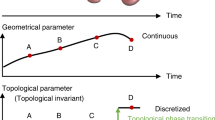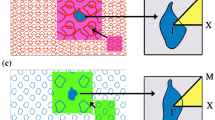Abstract
Chern number is one of the most important criteria by which the existence of a topological photonic state among various photonic crystals can be judged; however, few reports have presented a universal numerical calculation method to directly calculate the Chern numbers of different topological photonic crystals and have denoted the influence of different structural parameters. Herein, we demonstrate a direct and universal method based on the finite element method to calculate the Chern number of the typical topological photonic crystals by dividing the Brillouin zone into small zones, establishing new properties to obtain the discrete Chern number, and simultaneously drawing the Berry curvature of the first Brillouin zone. We also explore the manner in which the topological properties are influenced by the different structure types, air duty ratios, and rotating operations of the unit cells; meanwhile, we obtain large Chern numbers from–2 to 4. Furthermore, we can tune the topological phase change via different rotation operations of triangular dielectric pillars. This study provides a highly efficient and simple method for calculating the Chern numbers and plays a major role in the prediction of novel topological photonic states.
Similar content being viewed by others
References
Raghu S, Haldane F D M. Analogs of quantum-Hall-effect edge states in photonic crystals. Physical Review A, 2008, 78(3): 033834
Wu Y, Li C, Hu X, Ao Y, Zhao Y, Gong Q. Applications of topological photonics in integrated photonic devices. Advanced Optical Materials, 2017, 5(18): 1700357
Den N, Quantized M. Hall conductance in a two dimensional periodic potential. Physica A, 1984, 124(1): 199–210
Lu L, Joannopoulos J D, Soljačić M. Topological photonics. Nature Photonics, 2014, 8(11): 821–829
Chen X D, Zhao F L, Chen M, Dong J W. Valley-contrasting physics in all-dielectric photonic crystals: Orbital angular momentum and topological propagation. Physical Review B, 2017, 96(2): 020202
Gao Z, Yang Z J, Gao F, Xue H R, Yang Y H, Dong J W, Zhang B L. Valley surface-wave photonic crystal and its bulk/edge transport. Physical Review B, 2017, 96(20): 201402
Kang Y, Ni X, Cheng X, Khanikaev A B, Genack A Z. Pseudo-spin-valley coupled edge states in a photonic topological insulator. Nature Communications, 2018, 9(1): 3029
Berry M V. Quantal phase factors accompanying adiabatic changes. Proceedings of the Royal Society of London, Series A, 1802, 1984 (392): 45–57
Tomita A, Chiao R Y. Observation of Berry’s topological phase by use of an optical fiber. Physical Review Letters, 1986, 57(8): 937–940
Wang H X, Guo G Y, Jiang J H. Band topology in classical waves: Wilson-loop approach to topological numbers and fragile topology. New Journal of Physics, 2019, 21(9): 093029
Hatsugai Y. Chern number and edge states in the integer quantum Hall effect. Physical Review Letters, 1993, 71(22): 3697–3700
Wang Z, Chong Y D, Joannopoulos J D, Soljacić M. Reflection-free one-way edge modes in a gyromagnetic photonic crystal. Physical Review Letters, 2008, 100(1): 013905
Skirlo S A, Lu L, Soljačić M. Multimode one-way waveguides of large Chern numbers. Physical Review Letters, 2014, 113(11): 113904
Yang B, Zhang H F, Wu T, Dong R, Yan X, Zhang X. Topological states in amorphous magnetic photonic lattices. Physical Review B, 2019, 99(4): 045307
Ochiai T, Onoda M. Photonic analog of graphene model and its extension: Dirac cone, symmetry, and edge states. Physical Review B, 2009, 80(15): 155103
Fukui T, Hatsugai Y, Suzuki H. Chern numbers in discretized Brillouin Zone: efficient method of computing (spin) hall conductances. Journal of the Physical Society of Japan, 2005, 74(6): 1674–1677
Ringel Z, Kraus Y E. Determining topological order from a local ground-state correlation function. Physical Review B, 2011, 83(24): 245115
Yu R, Qi X L, Bernevig A, Fang Z, Dai X. Equivalent expression of Z(2) topological invariant for band insulators using the non-Abelian Berry connection. Physical Review B, 2011, 84(7): 075119
Ma T, Shvets G. All-Si valley-Hall photonic topological insulator. New Journal of Physics, 2016, 18(2): 025012
Ma T, Shvets G. Scattering-free edge states between heterogeneous photonic topological insulators. Physical Review B, 2017, 95(16): 165102
Ye L, Yang Y T, Hang Z H, Qiu C Y, Liu Z Y. Observation of valley-selective microwave transport in photonic crystals. Applied Physics Letters, 2017, 111(25): 251107
Gao F, Xue H R, Yang Z J, Lai K, Yu Y, Lin X, Chong Y, Shvets G, Zhang B. Topologically protected refraction of robust kink states in valley photonic crystals. Nature Physics, 2018, 14(2): 140–144
Xiao D, Yao W, Niu Q. Valley-contrasting physics in graphene: magnetic moment and topological transport. Physical Review Letters, 2007, 99(23): 236809
Shalaev M I, Walasik W, Tsukernik A, Xu Y, Litchinitser N M. Robust topologically protected transport in photonic crystals at telecommunication wavelengths. Nature Nanotechnology, 2019, 14 (1): 31–34
He X T, Liang E T, Yuan J J, Qiu H Y, Chen X D, Zhao F L, Dong J W. A silicon-on-insulator slab for topological valley transport. Nature Communications, 2019, 10(1): 872
Joannopoulos J D, Johnson S G, Winn J N, Meade R D. Photonic Crystals Molding the Flow of Light. 2nd ed. America: Princeton University Press, 2008, 1–283
Yang B, Wu T, Zhang X. Engineering topological edge states in two dimensional magnetic photonic crystal. Applied Physics Letters, 2017, 110(2): 021109
Chan H C, Guo G Y. Tuning topological phase transitions in hexagonal photonic lattices made of triangular rods. Physical Review B, 2018, 97(4): 045422
Acknowledgements
This paper was supported by the National Natural Science Foundation of China (Grant Nos. 11604378, 91850117, and 11654003), Beijing Institute of Technology Research Fund Program for Young Scholars, and Double First Class University Plan. We would like to thank Prof. Xiangdong Zhang, Dr. Lu He, Dr. Yujing Wang, and Dr. Changyin Ji from the Beijing Institute of Technology for the useful discussion.
Author information
Authors and Affiliations
Corresponding author
Additional information
Mr. Chenyang Wang is an undergraduate student majoring in Applied Physics at the Beijing Institute of Technology, China. His research interests include nanophotonics and topological photonic crystals. He successfully applied for one national invention patent as the co-inventor. Furthermore, he received the excellent poster award during the 2019 CPS Fall Meeting as well as a National Scholarship.
Dr. Hongyu Zhang received her bachelor’s degree from the Hebei Normal University in 2018. She is currently a graduate student at the Beijing Institute of Technology and studies the interaction between light and matter in nanostructures, including the metal nanoparticles and photonic crystal cavities. She successfully applied for two national invention patents as the second inventor and received a National Scholarship during her first year in graduate school. Currently, she is focused on researching topological photonics and hybrid cavity systems.
Mr. Hongyi Yuan is currently an undergraduate in the Physics Department at the Beijing Institute of Technology. His research is focused on the design, calculation and simulation of nanophotonic devices. He is currently focused on general designing using algorithms. He successfully applied for two national invention patents as the co-inventor.
Mr. Jinrui Zhong is an undergraduate student at the Beijing Institute of Technology. He has been awarded a scholarship every semester and received an A–in the astrophysics course during the summer school program at the University of California, Berkeley. His major research interests include the theory of topological fields, Weyl semimetal, chiral anomaly, and axion electric dynamics in condensed matter physics. As a big fan of Richard Feynman, he is independently pursuing Ph.D. while conducting quantum transport experiments.
Prof. Cuicui Lu received her Ph.D. degree from the Peking University in 2015 and is currently an associate research scientist at the Beijing Institute of Technology. Her research interests include nanophotonic devices based on algorithm, topological photonics, photonic crystal cavity and applications, and plasmonics. She has published 30 papers in several journals, including Light: Science & Applications, Optica, Nano Letters, Laser & Photonics Reviews, and Advanced Optical Materials. She has led six scientific research projects, including three projects of National Natural Science Foundations of China, two projects of the Beijing Institute of Technology, and one independent innovation project of the Qian Xuesen Space Technology Laboratory. She received the SPIE Optics and Photonics Education Scholarship and World Quantitative and Science Scholarship in 2014. Email: cuicuilu@bit.edu.cn
Rights and permissions
About this article
Cite this article
Wang, C., Zhang, H., Yuan, H. et al. Universal numerical calculation method for the Berry curvature and Chern numbers of typical topological photonic crystals. Front. Optoelectron. 13, 73–88 (2020). https://doi.org/10.1007/s12200-019-0963-9
Received:
Accepted:
Published:
Issue Date:
DOI: https://doi.org/10.1007/s12200-019-0963-9




